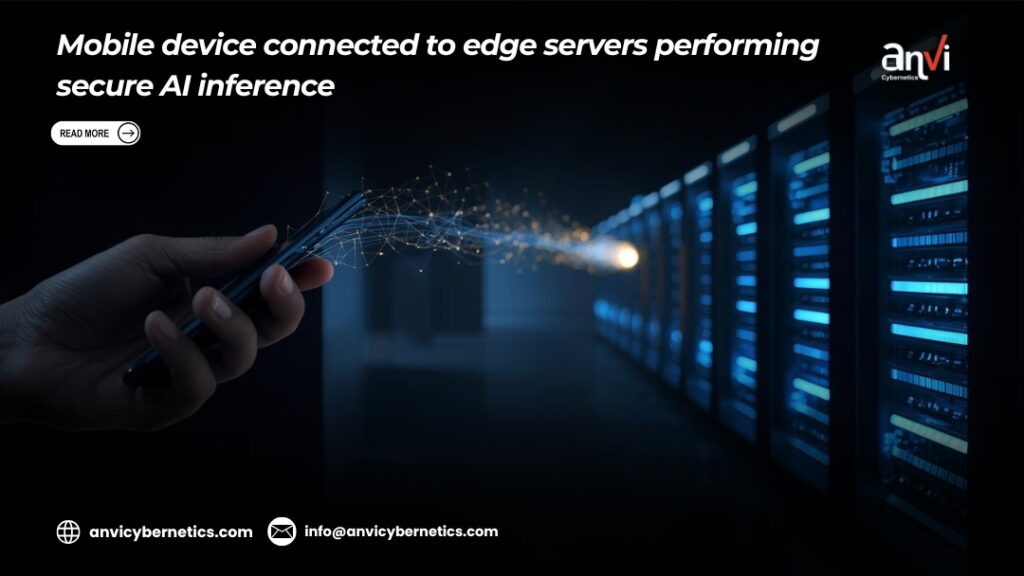
Edge-Backed Mobile Features: Offloading Heavy Inference Safely
Introduction
Modern mobile applications are evolving from static tools into AI-driven ecosystems capable of real-time translation, predictive insights, and hyper-personalized experiences. But as these capabilities expand, so does computational demand.
The challenge? Smartphones are powerful but not limitless. Running heavy AI or ML inference on-device strains CPUs, drains battery, and risks thermal throttling — especially when models exceed hundreds of megabytes.
That’s why developers are increasingly turning to edge-backed mobile features. These architectures offload complex inference tasks to nearby edge servers, cutting latency and power usage while improving responsiveness and user satisfaction.
In this guide, we’ll break down how edge-backed mobile features work, why safety and governance matter, and how to build scalable systems that balance speed, accuracy, and trust.
The Rising Need for Edge-Backed Mobile Features
Mobile AI workloads are exploding. According to Statista, the global edge computing market is projected to reach USD 155 billion by 2030, largely fueled by AI-enabled mobile experiences — from health tech to smart commerce.
Let’s understand why offloading inference to the edge is becoming mission-critical.
- Latency Kills User Experience
Milliseconds matter. Whether it’s gesture tracking, real-time translation, or navigation, users expect immediate feedback. Edge nodes positioned close to the user reduce round-trip latency from ~200 ms (cloud) to <30 ms (edge).
- Power and Thermal Constraints
Heavy model inference — like object detection using YOLOv8 or speech-to-text with Whisper — can quickly overheat phones and degrade battery. Edge processing removes that load.
- Privacy and Regulation
Regulations like GDPR, HIPAA, and CCPA require strict control over user data. Offloading anonymized data to local edge nodes avoids cross-border data transfers and meets compliance goals.
- Bandwidth and Scalability
Edge computing helps when millions of app sessions require inference simultaneously. Instead of hitting a central cloud, local nodes handle distributed requests efficiently.
How Edge-Backed Inference Works
A well-architected edge-backed mobile system looks like this:
- Capture → App collects input (camera feed, voice, or telemetry).
- Pre-processing → Lightweight data compression or embedding extraction occurs on-device.
- Secure Transfer → Payload is encrypted and sent via TLS 1.3 to a nearby edge data center.
- Edge Inference → High-capacity GPUs/TPUs process requests locally.
- Response → Edge node returns processed results (text, predictions, or visual overlays).
- UI Integration → App displays output seamlessly.
Leading cloud providers have embraced this model:
- AWS Wavelength integrates 5G-edge zones for low-latency apps.
- Azure Edge Zones connect directly to mobile carriers for real-time workloads.
- Google Distributed Cloud Edge brings GCP capabilities to telco networks for AR/VR and IoT apps.
Balancing On-Device, Edge, and Cloud Inference
Layer | Best For | Key Advantages | Examples |
On-Device | Lightweight, low-latency tasks | Offline use, privacy preservation | Wake-word detection, gesture recognition |
Edge | Real-time AI inference | Low latency, reduced device strain | AR object tracking, translation, navigation |
Cloud | Heavy training & analytics | Scalability, data aggregation | Global model updates, batch training |
Frameworks like TensorFlow Lite and Core ML make this hybrid model achievable — small models stay on-device, while larger ones are served at the edge.
Key Challenges and Safety Considerations
While edge inference offers speed and flexibility, unsafe design can backfire. Here are the main challenges:
- Data Security and Privacy
Every inference request might contain sensitive data — voice clips, images, or biometrics.
Best Practices:
- Use end-to-end encryption (E2EE) between device and edge.
- Apply federated learning or embedding extraction to minimize raw data transfer.
- Follow Zero Trust Architecture (NIST SP 800-207) to verify every node before exchange.
Network Reliability
Edge nodes may become temporarily unavailable.
Solution: Implement a fallback local model for degraded network states — a lighter version that preserves basic functionality offline.
- Version Synchronization
Out-of-sync app clients and edge models can trigger incorrect results.
Fix: Use version pinning in your deployment pipeline and staged rollouts through MLOps systems like Kubeflow or MLflow.
- Compliance Auditing
Maintain inference logs (timestamp, request ID, node location) to satisfy audits under GDPR or HIPAA frameworks.
Architectural Blueprint for Safe Edge Offloading
Data Layer:
- Handle local pre-processing and anonymization.
- Maintain transient caches; no raw data persistence.
Network Layer:
- Use mutual TLS (mTLS) for both device and edge authentication.
- Integrate with content delivery networks (CDNs) for routing optimization.
Inference Layer:
- Deploy GPU-backed microservices on Kubernetes clusters.
- Utilize autoscaling tools like KEDA to manage load peaks.
Monitoring Layer:
- Track performance using Prometheus (prometheus.io) and visualize metrics via Grafana (grafana.com).
- Monitor latency, throughput, and SLA compliance.
Governance Layer:
- Define access controls, incident response procedures, and compliance mapping.
Real-World Use Cases
- Healthcare: Predictive & Diagnostic Apps
AI-powered diagnostic tools analyze scans using edge nodes close to hospitals, enabling real-time results while keeping data within national borders.
Example: An edge-backed radiology platform reduces inference latency by 70%, accelerating diagnosis turnaround time.
- Retail & E-Commerce
AR try-on and visual recommendation engines process imagery at the edge. Localized models adjust to regional catalogs, lighting, and skin tones — boosting accuracy and inclusivity.
- Autonomous Mobility
Ride-hailing and smart city apps rely on edge inference for path prediction and safety alerts. Edge clusters support split-second decisions that cloud networks can’t deliver.
- Fintech & Security
Fraud detection models run near users to flag anomalies instantly without sending raw transaction data to the cloud.
- Media & Gaming
Low-latency streaming platforms leverage edge servers for dynamic bitrate adjustment, live translation, and closed captioning.
Performance Optimization Tips
- Edge CDN Routing: Use geolocation-based routing to ensure users hit the nearest edge node.
- Compression & Batching: Combine inference requests where possible to cut bandwidth cost.
- Adaptive Model Serving: Deploy multiple model sizes (tiny/medium/full) and dynamically select based on user bandwidth or device class.
- Profiling: Use TensorBoard or Weights & Biases for real-time model performance insights.
- Observability: Configure alert thresholds in Grafana for latency >100ms or inference failure spikes.
Developer Checklist
- Map which features can offload inference safely.
- Integrate TensorFlow Lite / Core ML for hybrid inference.
- Encrypt payloads using TLS 1.3 / mTLS.
- Set up edge clusters via AWS Wavelength / Azure Edge / Google Distributed Cloud.
- Monitor inference KPIs with Prometheus + Grafana.
- Enable rollback mechanism for model mismatches.
- Log all inference calls for compliance.
Governance & SLAs for Edge-Backed Features
Building reliable edge infrastructure requires clear service-level agreements (SLAs) between app teams, cloud providers, and edge operators.
Recommended SLA Metrics:
- Latency: 99th percentile below 50 ms.
- Uptime: ≥ 99.9% edge node availability.
- Security Response: Incident acknowledgment within 15 minutes.
- Version Drift: No more than 1 deployed model version difference across nodes.
Governance Practices:
- Establish a centralized model registry with approval workflows.
- Audit edge clusters monthly for compliance drift.
- Implement access control via IAM and continuous secret rotation.
Promotional Spotlight
Edge-backed mobile features are redefining the limits of app performance and intelligence.
At Anvi Cybernetics, our teams build secure, hybrid architectures that merge on-device optimization, edge inference, and scalable cloud orchestration — giving businesses the edge (literally) in user experience.
From healthcare to fintech and retail, we help clients design mobile ecosystems that process smarter, respond faster, and stay compliant across geographies.
👉 Explore our Mobile App Development Services
Conclusion
As mobile apps evolve into intelligent ecosystems, computation no longer lives in one place. The future belongs to distributed intelligence — a symphony between device, edge, and cloud.
Edge-backed mobile features bring this vision to life by shifting AI workloads closer to users — improving responsiveness, privacy, and scalability. But performance without safety is short-lived. Success requires thoughtful governance, encryption, fallback design, and observability.
The developers who master this tri-layered architecture — device + edge + cloud — will define the next era of high-performance, privacy-first mobile innovation.
Introduction
Modern mobile applications are evolving from static tools into AI-driven ecosystems capable of real-time translation, predictive insights, and hyper-personalized experiences. But as these capabilities expand, so does computational demand.
The challenge? Smartphones are powerful but not limitless. Running heavy AI or ML inference on-device strains CPUs, drains battery, and risks thermal throttling — especially when models exceed hundreds of megabytes.
That’s why developers are increasingly turning to edge-backed mobile features. These architectures offload complex inference tasks to nearby edge servers, cutting latency and power usage while improving responsiveness and user satisfaction.
In this guide, we’ll break down how edge-backed mobile features work, why safety and governance matter, and how to build scalable systems that balance speed, accuracy, and trust.
The Rising Need for Edge-Backed Mobile Features
Mobile AI workloads are exploding. According to Statista, the global edge computing market is projected to reach USD 155 billion by 2030, largely fueled by AI-enabled mobile experiences — from health tech to smart commerce.
Let’s understand why offloading inference to the edge is becoming mission-critical.
1. Latency Kills User Experience
Milliseconds matter. Whether it’s gesture tracking, real-time translation, or navigation, users expect immediate feedback. Edge nodes positioned close to the user reduce round-trip latency from ~200 ms (cloud) to <30 ms (edge).
2. Power and Thermal Constraints
Heavy model inference — like object detection using YOLOv8 or speech-to-text with Whisper — can quickly overheat phones and degrade battery. Edge processing removes that load.
3. Privacy and Regulation
Regulations like GDPR, HIPAA, and CCPA require strict control over user data. Offloading anonymized data to local edge nodes avoids cross-border data transfers and meets compliance goals.
4. Bandwidth and Scalability
Edge computing helps when millions of app sessions require inference simultaneously. Instead of hitting a central cloud, local nodes handle distributed requests efficiently.
How Edge-Backed Inference Works
Leading cloud providers have embraced this model:
Balancing On-Device, Edge, and Cloud Inference
Layer | Best For | Key Advantages | Examples |
On-Device | Lightweight, low-latency tasks | Offline use, privacy preservation | Wake-word detection, gesture recognition |
Edge | Real-time AI inference | Low latency, reduced device strain | AR object tracking, translation, navigation |
Cloud | Heavy training & analytics | Scalability, data aggregation | Global model updates, batch training |
Frameworks like TensorFlow Lite and Core ML make this hybrid model achievable — small models stay on-device, while larger ones are served at the edge.
Key Challenges and Safety Considerations
While edge inference offers speed and flexibility, unsafe design can backfire. Here are the main challenges:
1. Data Security and Privacy
Every inference request might contain sensitive data — voice clips, images, or biometrics.
Best Practices:
2. Network Reliability
Edge nodes may become temporarily unavailable.
Solution: Implement a fallback local model for degraded network states — a lighter version that preserves basic functionality offline.
3. Version Synchronization
Compliance Auditing
Maintain inference logs (timestamp, request ID, node location) to satisfy audits under GDPR or HIPAA frameworks.
Architectural Blueprint for Safe Edge Offloading
- Data Layer:
- Handle local pre-processing and anonymization.
- Maintain transient caches; no raw data persistence.
- Network Layer:
- Use mutual TLS (mTLS) for both device and edge authentication.
- Integrate with content delivery networks (CDNs) for routing optimization.
- Inference Layer:
- Deploy GPU-backed microservices on Kubernetes clusters.
- Utilize autoscaling tools like KEDA to manage load peaks.
- Monitoring Layer:
- Track performance using Prometheus (prometheus.io) and visualize metrics via Grafana (grafana.com).
- Monitor latency, throughput, and SLA compliance.
- Governance Layer:
- Define access controls, incident response procedures, and compliance mapping.
Real-World Use Cases
- Healthcare: Predictive & Diagnostic Apps
AI-powered diagnostic tools analyze scans using edge nodes close to hospitals, enabling real-time results while keeping data within national borders.
Example: An edge-backed radiology platform reduces inference latency by 70%, accelerating diagnosis turnaround time.
- Retail & E-Commerce
AR try-on and visual recommendation engines process imagery at the edge. Localized models adjust to regional catalogs, lighting, and skin tones — boosting accuracy and inclusivity.
- Autonomous Mobility
Ride-hailing and smart city apps rely on edge inference for path prediction and safety alerts. Edge clusters support split-second decisions that cloud networks can’t deliver.
- Fintech & Security
Fraud detection models run near users to flag anomalies instantly without sending raw transaction data to the cloud.
- Media & Gaming
Low-latency streaming platforms leverage edge servers for dynamic bitrate adjustment, live translation, and closed captioning.
Performance Optimization Tips
- Edge CDN Routing: Use geolocation-based routing to ensure users hit the nearest edge node.
- Compression & Batching: Combine inference requests where possible to cut bandwidth cost.
- Adaptive Model Serving: Deploy multiple model sizes (tiny/medium/full) and dynamically select based on user bandwidth or device class.
- Profiling: Use TensorBoard or Weights & Biases for real-time model performance insights.
- Observability: Configure alert thresholds in Grafana for latency >100ms or inference failure spikes.
Developer Checklist
- Map which features can offload inference safely.
- Integrate TensorFlow Lite / Core ML for hybrid inference.
- Encrypt payloads using TLS 1.3 / mTLS.
- Set up edge clusters via AWS Wavelength / Azure Edge / Google Distributed Cloud.
- Monitor inference KPIs with Prometheus + Grafana.
- Enable rollback mechanism for model mismatches.
- Log all inference calls for compliance.
Governance & SLAs for Edge-Backed Features
Building reliable edge infrastructure requires clear service-level agreements (SLAs) between app teams, cloud providers, and edge operators.
Recommended SLA Metrics:
- Latency: 99th percentile below 50 ms.
- Uptime: ≥ 99.9% edge node availability.
- Security Response: Incident acknowledgment within 15 minutes.
- Version Drift: No more than 1 deployed model version difference across nodes.
Governance Practices:
- Establish a centralized model registry with approval workflows.
- Audit edge clusters monthly for compliance drift.
- Implement access control via IAM and continuous secret rotation.
Promotional Spotlight
Edge-backed mobile features are redefining the limits of app performance and intelligence.
At Anvi Cybernetics, our teams build secure, hybrid architectures that merge on-device optimization, edge inference, and scalable cloud orchestration — giving businesses the edge (literally) in user experience.
From healthcare to fintech and retail, we help clients design mobile ecosystems that process smarter, respond faster, and stay compliant across geographies.
👉 Explore our Mobile App Development Services
Conclusion
As mobile apps evolve into intelligent ecosystems, computation no longer lives in one place. The future belongs to distributed intelligence — a symphony between device, edge, and cloud.
Edge-backed mobile features bring this vision to life by shifting AI workloads closer to users — improving responsiveness, privacy, and scalability. But performance without safety is short-lived. Success requires thoughtful governance, encryption, fallback design, and observability.
The developers who master this tri-layered architecture — device + edge + cloud — will define the next era of high-performance, privacy-first mobile innovation.




